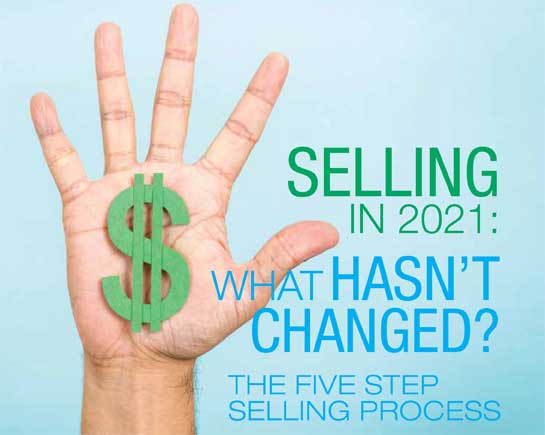Selling in 2021

by Troy Harrison
First of all, mea culpa. I’m as guilty as anyone else of what I’m about to write about. I’ve been focused, as so many other sales authors have been, on what changed during 2020 (and the years immediately preceding). And it’s true; the changes have been significant. We’ve seen entire industries being rocked or overturned. We’ve seen travel restricted or in some cases prohibited. We’ve seen technology take over some phases of selling. And yet, there’s a lot that hasn’t changed about selling. That will be the focus of this article.
People are still buying things.
Salespeople are still selling things.
And the customer’s basic buying process is still intact. Customers buy things in a defined five-step process.
The first step is Motivation.
The customer recognizes that a need may exist that could be satisfied by making a purchase of some good or service. This motivation can come in a variety of methods; the customer could see an advertisement, or the customer could receive a sales message (for instance, a cold call), or something in the customer’s sphere could change (for instance, a broken machine or device could mean that the customer needs to purchase a new device). This step is what gets the customer out of the status quo and (potentially) into a process to buy something. If you will, think of the most basic buying process – lunch. The
motivator here is, “I’m hungry and it’s about noon.”
What the salesperson must do at this stage – assuming that the salesperson is prospecting and attempting to initiate motivation in his/her customers – is to give the customer a good and concise reason to entertain a conversation.
The second step is Investigation.
In this step, the customer more fully defines his or her needs and parameters. Depending on the customer, this can involve a simple internal dialogue, extensive internet research, or (preferably) this step includes a salesperson doing a comprehensive discovery/questioning phase. A knowledgeable and skilled salesperson can bring out needs that the customer might not have even recognized or defined. In the lunchtime process, the investigation usually is, “What kind of food sounds good, and what’s near me?”
The salesperson’s duty to the customer is to execute a quality discovery process, using good open ended probing questions designed to discover customer needs, not just a few leading questions designed to maneuver a customer into a corner so they “can’t” not buy. In a B2B environment, the salesperson should be learning about the company’s
overall needs and priorities as well as the company’s needs related to the salesperson’s products or services.
The third step is Selection. Once the customer has defined their needs, they then proceed to figuring out which products or services best match their needs. This could hinge on product specifications, service availability, customer comfort or any other needs and parameters that the customer has established – but in this step, some products/services are included and some are excluded. For the salesperson, this is the presentation phase in selling. In the lunchtime scenario, the selection might be, “I want tacos (always a sure bet with me), and there are three Mexican places just up the street.”
What the customer wants from the salesperson at this phase of the process is a targeted presentation (rather than a one-size-fits-all slide deck) on why the product solves the specific needs of the customer, rather than a blanket presentation. The salesperson should also be prepared to offer quality advice on the use and implementation of the product or service – to genuinely be the consultant that so many salespeople claim to be.
The fourth step is Evaluation.
This is the “price and terms” step of the process. The customer is asking themselves, “Can I afford it? Does this represent good value? Are the terms and delivery acceptable?” For the salesperson, this is the proposal phase of selling. In my lunchtime scenario, I might think, “Well, there’s a very nice Mexican restaurant up the street, but it can take some time – I’d better go to the quick taco joint right here, because my time is tight.”
At this stage, the customer needs simplicity in the proposal. Make the price and terms simple and easy to understand – the more words you use, the more uncertainty in the customer’s mind – which harms trust and customer comfort. The proposal doesn’t sell for you – it simply confirms the terms under which the customer buys.
The fifth and final step is Decision.
This is where the customer either buys or doesn’t buy. This, in the lunchtime scenario, is where I pull into my taco joint (I’m writing this right before lunch – I bet you can guess what I’ll be having by now).
What the customer wants from the salesperson in this closing phase is simple. Ask the customer to buy. Yes, the customer wants that – this brings a close to their process, one way or another, and they are expecting that.
This process hasn’t changed, even through all the upheavals of 2020, and it won’t, because it rests in human nature. Yes, technology, COVID-19 and regulations have changed the way in which many of these things happen – but they all still happen. That’s good news for us, because our profession is still vital and still important to our customers. So – learn new tools, learn new techniques and new contact methods – but remember how the customer buys.
Moreover, respect how the customer buys. The arbiter of when it’s time to move from step to step is the customer – not you. They will let you know. If you attempt to push your customer through the process just to get a quick sale, they will disconnect.
 Troy Harrison is the author of “Sell Like You Mean It!” and his new book, “The Pocket Sales Manager.” He is a speaker, consultant and sales navigator. He helps companies build more profitable and productive sales forces with his cutting-edge sales training and methodologies. For information on booking speaking/training engagements, consulting, or to sign up for his weekly E-zine, call (913) 645-3603, e-mail Troy@TroyHarrison.com, or visit www.TroyHarrison.com.
Troy Harrison is the author of “Sell Like You Mean It!” and his new book, “The Pocket Sales Manager.” He is a speaker, consultant and sales navigator. He helps companies build more profitable and productive sales forces with his cutting-edge sales training and methodologies. For information on booking speaking/training engagements, consulting, or to sign up for his weekly E-zine, call (913) 645-3603, e-mail Troy@TroyHarrison.com, or visit www.TroyHarrison.com.
This article originally appeared in the Jan./Feb. 2021 issue of Industrial Supply magazine. Copyright 2021, Direct Business Media.











